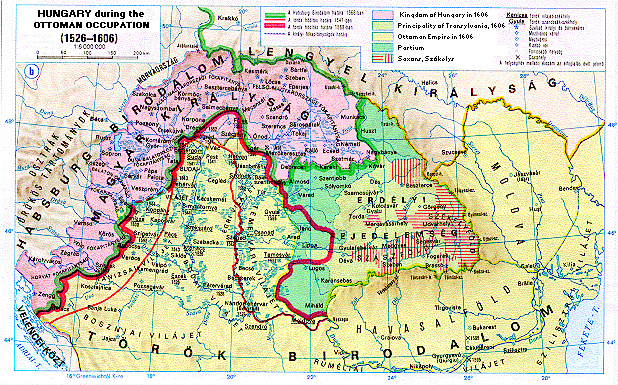A Definition of Everyday Life of the Military Frontier in a historical aspect within the Hungarian Kingdom during the 17th century (The work of Dr. Illik Péter / the pictures were inserted by Szántai Gábor.)
The interpretation of the frontier is rather complex in European and American historiography and frontier studies. For instance, Owen Lattimore’s “Collected Papers” concentrated on the Asian frontiers from a socio-cultural perspective, covering a variety of topics such as the Great Wall as a border and feudalism in History. (1) The book by Andrew C. Hess aimed at a military and cultural summary of Spanish-Muslim border fights in North Africa. As he wrote: ”One obvious arena for such a frontier history within a larger framework is the wide meeting ground at the western end of the Mediterranean, where Latin Christendom and Islam had comingled since the eighth century.” (2)

This complexity is also highlighted by various essay approaches in “Frontiers and the Writing of History 1500–1850”. (3) They tell about frontiers between geography and history, Tudor frontiers, urban identities in the Netherlands, confessional frontiers, etc. In their introduction, Steven G. Ellis and Raingard Eßer highlight that “There are, obviously, as many ways to approach the topic as there are definitions and interpretations of frontiers in history. […] In English usage, the terms ‘border’ and ‘frontier’ are often used interchangeably; strictly speaking, ‘border’ is a more general term denoting the edges of a garden as well as political divisions between states. […] In the late 16th and increasingly in the 17th century the term ‘border’ was applied to describe ‘visible line” between territories. […]” (4) Among these studies, William O’Reilly analysed the Habsburg military frontier (which “[…] comprised of military and civilian outposts along an ever changing frontier stretching the Adriatic to Transylvania.”) (5) and its historiography concentrating on the anti-Turkish defence system and its organisation in a wide geographical (from the Adriatic to Transylvania) and chronological context (from the 16th to 19th century). (6)

The cultural and military interpretation of the frontier can be combined, for example, in Hungarian historiography Erdélyi Gabriella pointed out that Ottomans raided and plundered the Hungarian territories during their conquest in the 16th century. However, this encounter of the two cultures also provided opportunities for some people to enter another culture. (7)

From a practical, history of life point of view, the military frontier between the Habsburg and the Ottoman Empires can be interpreted in another way in the 17th century. In 1541, Ottomans captured the city and fortress of Buda, and from this central foothold, they started to create and expand a territory under Turkish rule. (8) The military-political situation was partly stabilised by 1568. This way, the Ottoman Empire intruded into the central part of the Hungarian Kingdom, dividing it into three parts: the remnant of the Hungarian Kingdom, the territory under Turkish rule, and a Turkish vassal state, the Transylvanian Principality.

The first two regions were separated by the Hungarian and Turkish defence lines of fortresses. Strictly speaking, the latter is the military frontier or border. As these defence lines were not hermetically closed systems, the Ottomans could penetrate the Hungarian defence system to plunder the territories behind it. Therefore, the situation became slightly analogous to the 20th-century wars: the frontier merged with the hinterland. Thus, the concept of military frontier can be interpreted in a wider context than a mere strip of fortresses. (9)
Of course, this was not a total war, but an everyday war for soldiers of the fortresses and the inhabitants of the hinterland as well, as the frontier of the Hungarian Kingdom and the Turkish Empire merged, and with the hinterland behind the line of fortresses. It is worth noting that the Hungarian situation was not completely unique; there are other examples in the Balkans or Northern Africa (10), but in this case, the vast amount of sources gives special insight into the life of the inhabitants (villagers and city dwellers) and soldiers of the frontier.

After the long war (1591–1606), a peaceful period started with the Habsburg-Turkish peace treaty of Zsitvatorok (1606). This treaty was confirmed several times until 1683, when the reconquest of Hungary started. Under the aegis of the officially peaceful period, the Ottomans constantly raided the Hungarian hinterland. They threatened and subjugated villages, kidnapped and killed villagers and soldiers of the fortresses as well. (11) Consequently, in this aspect, the territory of the Hungarian Kingdom was divided into five parts: (1) Transylvanian principality, (2) (the remnant of the) Hungarian Kingdom (3), (footnote: 12) the territory under Turkish rule, (4) fringes of the territory under Turkish rule in the Hungarian Kingdom: the areas of villages behind the Hungarian line of fortresses which were subjugated and harassed by the Ottomans, (5) “nobody’s land” between the Hungarian and Turkish lines of fortresses. (footnote: 13) In this sense, the Hungarian section of the military frontier between the Ottoman Empire and the Habsburg Empire meant the border of fortresses and the fringes of the territory under Turkish rule together. This latter geographically meant a part of counties including Vas, Zala, Győr, Veszprém (footnote: 14), Hont, Borsod, Abaúj, Torna, Zemplén, Heves, Gömör, Nógrád, and Bars. (footnote: 15)

As the Hungarians prepared for peace treaty negotiations, especially for the first and second treaties at Szőny (1627, 1642), they collected the grievances of the soldiers of the fortresses and of the inhabitants of the fringes. These Turkish violations of peace (e. g. subjugation of villages, raising taxes of already submitted territories, murder and kidnapping of villagers and soldiers) were written in lists, conscriptions. Therefore, there are a vast number of sources (16) on the harshness of life on the military frontier, even if some of these pieces of information are contradictory and raise philological problems.

Based on these sources, the terms ‘peace, ’ ‘war,’ and ‘military frontier’ can be redefined. During the 17th century in the Hungarian Kingdom, there were periods of declared war and campaigns (1591–1606, 1663–1664, 1683–1699) and intervals defined by official peace treaties, when military activities did not cease to exist; however, they were restricted and reduced to border clashes and incursions. Therefore, the military frontier in Hungary did not narrow down to the strip of fortresses, as Ottoman raiding parties regularly penetrated them and pillaged the inner territories behind. Hence, the fringes of the territory under Turkish rule covered an ever-changing part (17) of the Hungarian Kingdom.
Author: Dr. Illik Péter

Footnotes:
1 – Lattimore, 1962.
2 – Hess, 1978, p. 4.
3 – Frontiers and the Writing of History 1500–1850.
4 – Ibid., pp. 10–13.
5 – O’Reilly, p. 229. It is also defined on page 231.“The Militärgrenze or Military Frontier region comprised some 33,4222 square kilometres by 1881 with over 1.2 million inhabitants, and extended as a narrow strip of land over 1,900 kilometres of border with the Ottoman Empire from the Adriatic to the borders of Northern Transylvania.”
6 – O’Reilly, pp. 229–244.
7 – Erdélyi, 2012, pp. 89–90.
8 – However, they gained a foothold in the Hungarian Kingdom in 1521, after the occupation of Nándorfehérvár.
9 – In this essay’s interpretation, the Hungarian military frontier in the 17th century includes those parts of the Hungarian Kingdom that were behind the line of fortresses but were hit by the Ottomans.
10 – “A határvidék másik sajátos vonása a condominium, azaz a korábbi hatalmi elit és az oszmán hatóságok hosszabb-rövidebb ideig tartó közös uralma, osztozkodása a hatalmon, amely régiónként és korszakonként jelentős különbségeket mutatva ugyan, de kiterjedhetett a közigazgatás, a jogszolgáltatás és az adóztatás területeire. Jóllehet az oszmánok kezdetben hallani sem akartak a magyar rendek oszmán területeken folytatott adóztatásáról és jogszolgáltatásáról, a katonai egyensúlyhelyzet és főként a magyar végvári katonaság fegyverei végül is mindkettőt kikényszeríttették és mindennapos gyakorlattá tették. Mindez azonban hosszabb-rövidebb ideig kialakult azokon a területeken is, amelyeket az oszmánok nem tudtak teljes egészében meghódítani és betagolni birodalmuk törzsterületei közé, és ahol a korábbi elit meg tudta őrizni pozícióit és fegyveres erejét, miként arra a Balkánról, a kelet-anatóliai vagy az arab területekről is számos példát lehet említeni.” (Ágoston, 2003. p. 70.) and “Észak-Afrikában a védelmi probléma világosabban körvonalazódik, mint egyebütt. […] A presidiók, parti erődök lánca csak vékony vonal ugyan, de szorosan kapcsolódik azoknak a kultúráknak a történetéhez, amelyeket elválaszt. Ezért is tudunk annyi mindent az erődrendszerek egészéről és részleteiről. […] Valójában azonban 1560 és 1570 között türelmes kitartással, nem látványos, de hosszú távon hatékony politikát követve megerősítették és továbbfejlesztették valamennyi erődöt. […]A parti erődök őrzése 1564–1568 között mintegy 2500 embert (2850) köt le állandó helyőrségenként és 2700 embert rendkívüli állományként. […] Az erődök élete nyomorúságos lehetett. […] A katonák egész évben éheznek. […]Minden erőd főkapitányának hitbizománya, Melilla a Medina Sidoniáké, Orán pedig az Alcaudete családé. […] Az erődök gazdáinak pedig egyetlen játéka akad a jól kiszámított portya, amely egyszerre sport és ipar, de, ismerjük el, szükségesség is: az erőd környékén csendőri szolgálatot kell végezni, emezeket szét kell szórni, amazokat meg kell védeni, zálogot kell begyűjteni, információkat kell szerezni, élelmiszert kell zsákmányolni. […] Ugyanakkor a törökök a perzsákkal szemben limest építettek ki.” (Braudel, 1996, pp. 903–914.)
11 – Illik, 2012, pp. 45–53. (http://ganymedes.lib.unideb.hu:8080/dea/handle/2437/131061) and Illik (forthcoming, 2012).
12 – This part is often called Royal Hungary in the Hungarian historiography.
13 – Szakály, 1981, p. 24.
14 – See Illik, 2010.
15 – See Illik (forthcoming, 2013).
16 – Major manuscripts in Hungarian archives: MOL [Magyar Országos Levéltár=Hungarian National Archives] Magyar Kancelláriai Levéltár, Magyar Királyi Kancellária regisztratúrája, Transylvanica, A 98 13. fasciculus, MOL Batthyány család Levéltára, Török vonatkozású iratok P 1313/248–249. csomók, Hadtörténelmi Levéltár [= Military Archives] A török hódoltság és a török elleni háborúk iratai 1500–1789., VII. 201. 1616/7 and 1674/1., Győr-Moson-Sopron Megye Győri Levéltára [= Archives of Győr-Moson-Sopron counties in Győr] IV A. 1/b. 1629. I/48., 1641. II/10., 1647. II/14. Major published sources: Borsod vármegye adózása a török korban, 2005. (http://publikacio.uni-miskolc.hu/data/ME-PUB-41020/borsodadozas.pdf), Dongó Gyárfás, 1912–1913, Merényi, 1897, Ráth, 1860, Stahl, 1970.
17 – It always depended on Turkish military activity.
List of sources and bibliography
Sources used:
1. MOL [Magyar Országos Levéltár=Hungarian National Archives] Magyar Kancelláriai Levéltár, Magyar Királyi Kancellária regisztratúrája, Transylvanica, A 98 13. fasciculus
2. MOL Batthyány család Levéltára, Török vonatkozású iratok P 1313/248–249. csomók
3. Hadtörténelmi Levéltár [= Military Archives] A török hódoltság és a török elleni háborúk iratai 1500–1789., VII. 201. 1616/7 and 1674/1.
4. Győr-Moson-Sopron Megye Győri Levéltára [= Archives of Győr-Moson-Sopron counties in Győr] IV A. 1/b. 1629. I/48., 1641. II/10., 1647. II/14.
5. Borsod vármegye adózása a török korban, published: Bodnár, Tamás, Tóth, Péter, in: Borsod-Abaúj-Zemplén megyei Levéltári Füzetek 44., Miskolc, 2005. (http://publikacio.uni-miskolc.hu/data/ME-PUB-41020/borsodadozas.pdf)
6. Dongó Gyárfás, Géza, A törökök rablásai Szerencs tartományban (1630–1649) I–VI., Adalékok Zemplén-vármegye történetéhez 1912/9–12, pp. 286–289., 1913/1, pp. 78–79., 1913/2, pp. 161–162., 1913/3, pp. 246–248., 1913/4, pp. 329–330. (OSZK Mikrofilmtár FM/3/12708. 7–8. doboz.)
7. Merényi, Lajos, Bars, Hont és Nógrád 1630-iki sérelmei a török végbeliektől, Hadtörténelmi Közlemények 1897, pp. 448–451.
8. Merényi, Lajos, Heves vármegye panaszai a török ellen. 1629, Hadtörténelmi Közlemények 1897, pp. 302–305.
9. Ráth, Károly, Győr vármegyének 1642. évben összeírt sérelmi jegyzőkönyve a török ellen, Magyar Történelmi Tár 1860, pp. 92–123.
10. Stahl, Ferenc, Vas megyei török hódoltság összeírása a XVII. század közepéről. Vasi Szemle 1970/1–2, pp. 114–123, 298–308.
Bibliography:
1. Owen Lattimore, Studies In Frontier History, Collected Papers 1928–1958., London, Oxford University Press, 1962. Digital publication, Universal Digital Library, 2004.:
http://www.archive.org/stream/studiesinfrontie017780mbp#page/n475/mode/2upy-political
2. Andrew C. Hess, The Forgotten Frontier: A History of the Sixteenth-Century Ibero-African Frontier, Chicago University Press, Publications of the Center for Middle Eastern Studies, 1978.
3. Frontiers and the Writing of History 1500–1850, edited: Steven G. Ellis, Raingard Eßer, Hannover-Laatzen, Wehrhahn Verlag, 2006.
4. William O’Reilly, Border, buffer and bulwark, The Historiography of the military frontier, 1521–1881, in: Frontiers and the Writing of History 1500–1850., edited: Steven G. Ellis, Raingard Eßer, Hannover-Laatzen, Wehrhahn Verlag, 2006, pp. 229–244.
5. Erdélyi, Gabriella, Túlélési stratégiák a török idején, in: Identitás és kultúra a török hódoltság korában, edited: Ács, Pál, Székely, Júlia, Bp., 2012, pp. 89–100.
6. Ágoston, Gábor, Az Iszlám erős védőgátja: az oszmán és a magyarországi oszmán végvidék, in: A magyar hadtörténelem évszázadai, edited: Király, Béla, Veszprémy, László, Bp., 2003, 61–77.
7. Fernand Braudel, A Földközi-tenger és a Mediterrán világ II. Fülöp korában, Bp., Osiris, 1996, pp. 903–914.)
8. Illik, Péter, „…I am selling your son to the janissaries …” – Turkish threats and plundering in the Batthyány-estates, Kritische Zeiten 2012/1–2, pp. 45–53.
9. Illik, Péter, Life and death of soldiers of fortresses in the Hungarian kingdom during the first half of the 17th century in the mirror of lists of grievances, forthcoming 2012.
10. Illik, Péter, Török dúlás a Dunántúlon, Szigetmonostor, 2010.
11. Illik, Péter, Minden nap háború: a magyar királyságbeli török kártételek anatómiája (1627–1642), forthcoming, 2013.
12. Szakály, Ferenc, Magyar adóztatás a török hódoltságban, Bp., 1981.


